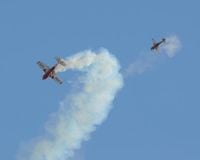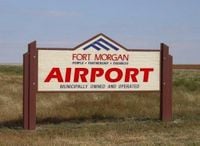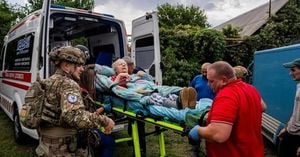On a clear Sunday morning, September 7, 2025, the skies above Fort Morgan Municipal Airport in Colorado were suddenly filled with the roar and chaos of disaster. Two small planes, a Cessna 172 and an Extra Flugzeugbau EA300, collided in midair as they approached the airport, resulting in a fiery crash that killed one person and injured three others. The tragic event has left the local aviation community shaken and raised pressing questions about flight safety at nontowered airports.
The Morgan County Sheriff’s Office received the first report of the crash at about 10:45 a.m. local time. Deputies and emergency crews rushed to the scene, where they found the wreckage of two aircraft scattered in fields just outside the airport. According to the sheriff’s office and the Federal Aviation Administration (FAA), both planes had caught fire upon impact, sending plumes of smoke into the sky. Bystanders and first responders scrambled to extinguish the flames, but the devastation was already done.
Each aircraft carried two people. The Cessna’s occupants, remarkably, suffered only minor injuries and were treated and released at the scene, as reported by the Morgan County Sheriff’s Office. The Extra EA-300, however, fared much worse. One of its occupants was taken to a local hospital, while the other was pronounced dead at the scene by the Morgan County Coroner’s Office. The names of those involved have not been released, out of respect for the families and as the investigation continues.
According to the National Transportation Safety Board (NTSB), which is now leading the investigation, both aircraft were attempting to land on Runway 14 at the nontowered airport. The Cessna 172—identified by its tail number N61657—was on a straight-in approach, a maneuver where the pilot lines up directly with the runway from a distance, rather than flying a standard traffic pattern. The Extra EA-300 (N333AN), a low-wing aerobatic aircraft, was executing a left turn from base to final approach, a standard part of the traffic pattern. It was during this maneuver that the Extra collided with the Cessna, clipping it midair.
Witnesses described seeing the planes "clip each other before plummeting to the ground," adding a chilling firsthand account to the official reports. Both aircraft burned fiercely after hitting the ground, with photos and videos posted to social media within an hour showing a large, charred area on the grass and the blackened remains of the planes. Parts of the Cessna, including a wing, were thrown onto the runway, a stark testament to the force of the impact.
The Morgan County Sheriff’s Office expressed gratitude to citizens who tried to put out the flames before emergency services could arrive, stating in a Facebook post: "We extend our deepest condolences to the family and friends of the victim in this tragic event. This is an active investigation and the names of the parties involved are not being released at this time."
Multiple agencies responded to the accident, including the Morgan County Sheriff’s Office, Fort Morgan Police Department, Colorado State Patrol, Fort Morgan Fire Department, and Morgan County Ambulance. The swift response was critical, given the possibility—reported in law enforcement dispatch audio—of someone being trapped in one of the burning aircraft.
The NTSB has begun a comprehensive investigation, which, according to the agency, "involves three primary areas: the pilot, the aircraft, and the operating environment." Investigators are gathering flight track data, any available air traffic control (ATC) communications, aircraft maintenance records, weather reports, pilot experience, and even information from electronic devices and surveillance video. Witness statements are also being collected to piece together the moments leading up to the collision. As is standard practice, the NTSB will not speculate on the cause of the accident until the investigation is complete.
Initial data suggests a potential issue with visibility and communication. In a low-wing aircraft like the Extra EA-300, a left turn with the wings up can obstruct the pilot’s view to the right—exactly where the high-wing Cessna would have been approaching. This classic blind spot scenario is a known risk, especially at airports like Fort Morgan Municipal, which do not have control towers to coordinate landings and departures.
Fort Morgan Municipal Airport itself has a storied history. Built in 1933 as Young Municipal Field, it was used for agricultural aviation and, during World War II, as a training site for glider pilots. Today, the airport boasts three runways: 14/32 (concrete, 5,219 feet), 17/35 (turf, 3,800 feet), and 8/26 (turf, 2,467 feet). The field sits at an elevation of 4,595 feet and uses a common traffic advisory frequency (CTAF) of 123.05 for pilot communications. There is an RNAV approach to Runway 14, which could result in a straight-in landing, but it has not been confirmed if the Cessna was using this procedure or if the pilots were communicating on the CTAF at the time of the collision.
The Cessna 172 is owned by Bell Ornithopters Flying Club Inc. of Denver, while the Extra EA-300 is registered to 333AN LLC in Castle Rock, Colorado. Both aircraft are popular in their respective niches: the Cessna 172 as a staple for flight training, and the Extra EA-300 for aerobatics.
The FAA’s Advisory Circular C No: 90-66c specifically addresses straight-in approaches at nontowered airports, noting that while such approaches are permitted, clear communication on the CTAF is essential. The advisory warns: "Pilots should clearly communicate on the CTAF and coordinate maneuvering for and execution of the landing with other traffic so as not to disrupt the flow of other aircraft. Therefore, pilots operating in the traffic pattern should be alert at all times to aircraft executing straight-in landings, particularly when flying a base leg prior to turning final."
This tragic incident has brought renewed attention to these safety recommendations. The clear weather on the morning of the crash, the lack of a control tower, and the classic blind spot between high-wing and low-wing aircraft all appear to have played a role. As the NTSB continues its investigation, the aviation community and local residents alike are left to reflect on the delicate balance of skill, communication, and luck that governs flight in even the quietest corners of America.
The aftermath of the Fort Morgan crash serves as a somber reminder of the ever-present risks in aviation and the importance of vigilance, training, and communication—especially in environments where pilots must rely on each other to stay safe.





